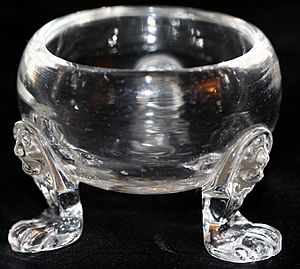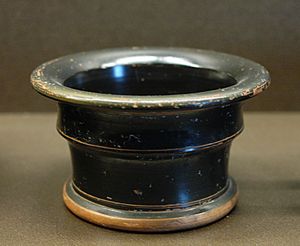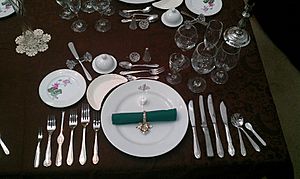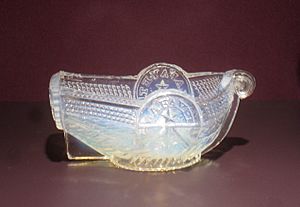Salt cellar facts for kids
A salt cellar is a small container used to hold and serve salt at the table. People also called them 'salt-boxes' or 'salt pigs'. In some places, like North America, people use the term 'salt shaker' more often.
Salt cellars can have lids or be open. They come in many sizes, from large ones shared by everyone to small dishes for just one person. They can be simple or very fancy. They are made from different materials like glass, ceramic, metal, ivory, wood, and plastic.
People have used salt cellars since the time of ancient Rome. They were common until the early 1900s. After 1911, when salt that didn't clump together became available, salt shakers became more popular. Now, salt cellars are mostly replaced by shakers.
Salt cellars became popular items to collect. After salt shakers took their place, many people started collecting old salt cellars.
What's in a Name?
The name "salt cellar" has been used in English since the 1400s. It combines the English word salt with an old French word, saler. The word saler already meant "salt container" by itself.
Salt cellars have had many different names over time. Some names include "open salt," "salt dip," "standing salt," and "master salt."
- A master salt was a large container. People would fill smaller salt dishes from it. It might have a lid or be covered with a cloth.
- A standing salt was a master salt that stayed in one place on the table. It was not passed around.
- A trencher salt was a small salt cellar placed right next to a person's plate.
- Open salt and salt dip mean salt dishes that did not have a cover.
Sometimes, the term "salt cellar" is used for any container that holds table salt. This includes modern salt shakers and salt pigs.
A Long History of Salt
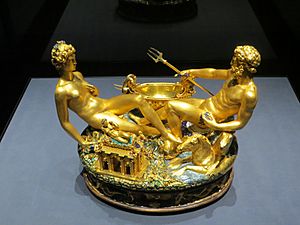
Ancient Greek bowls are sometimes called salt cellars. We are not sure what they were used for, but they might have held salt or other seasonings. The Romans had a special container called a salinum. It was usually made of silver. This container was very important in every Roman home. The salinum was used for a salt offering during meals. It also held salt for people to use.
During the Middle Ages, very fancy master salt cellars became popular. These large containers were placed at the main table. They showed how important and wealthy the family was. They were often made of silver and decorated with sea designs.
Besides the master salt, smaller, simpler salt cellars were shared by other guests. These could even be as simple as pieces of old bread. A guest's social status could be seen by where they sat. Important guests sat above the salt, meaning closer to the master salt. Less important guests sat below the salt.
Large, decorated master salts continued to be made through the Renaissance and Baroque periods. They became even more for show than for use. In England, these fancy master salts were called "standing salts" because they stayed in one place. By the late 1500s, smaller "trencher salts" were also used. By the early 1700s, these smaller salts had mostly replaced the large ones. Tiny salt spoons also started appearing in the 1600s as trencher salts became more common.
The Industrial Revolution began in the late 1700s. This made both salt and salt cellars much more common and affordable. Around 1825, making pressed glass became a big industry. Salt cellars were among the first items made this way because they were easy to mold. Also, new ways to make silver-plated items, like Sheffield plate (1700s) and electroplating (1800s), led to many affordable salt cellars.
Salt shakers started to appear in the Victorian era. People tried to solve the problem of salt clumping inside them. But shakers were not common yet. It was not until after 1911 that salt shakers became popular. This was when special ingredients were added to table salt to stop it from clumping. After this, open salt cellars were used less and less.
Collecting Salt Cellars
People have collected tableware made of silver, glass, china, and other materials for a long time. Salt cellars became collectible as part of these collections. By the 1930s, salt cellars themselves became popular to collect. This might be because they were common and affordable. Or perhaps it was because they became old-fashioned and charming.
It is not hard to find old salt cellars, and they can be quite cheap. But modern companies and artists still make new salt cellars today. You can find copies of old designs and new designs that fit modern tastes.


